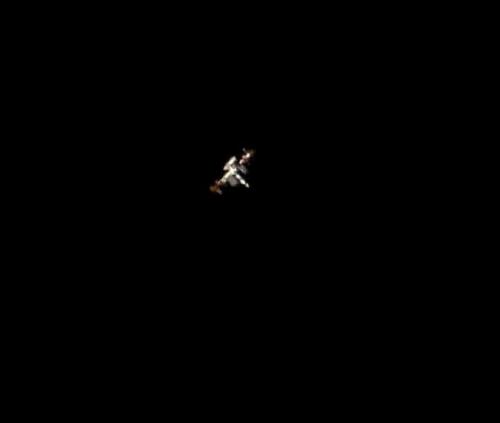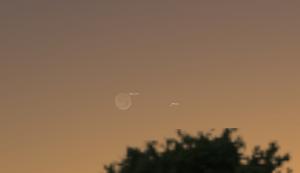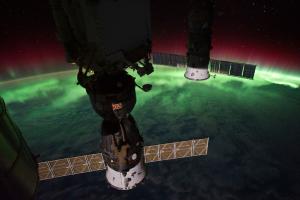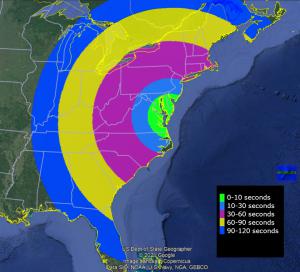Celebration of Space - May 14, 2021

The International Space Station (ISS) as it passes over Southern New England. Image Credit: Robert Horton.
On Monday, May 17, 2021, Mercury will achieve Maximum Eastern Elongation. This happens when Mercury reaches the point in its orbit where it is at tangent on the western side of the Sun when viewed from Earth. In non-geek terms, that means Mercury is at its highest viewing point in the evening before continuing its orbit towards inferior conjunction (orbits between the Earth and the Sun). This in itself is super cool because Mercury will be visible as a 43% waning crescent. But there is something else that is happening in conjunction that makes this specific elongation better than usual.
As Earth orbits the Sun, our axial tilt (23.4°) stays the same, but the orientation of our tilt, as it relates to the Sun, changes. On the Solstices we arrive at the points along our orbit where our tilt is at maximum either towards or away from the Sun. On the Equinoxes our orientation puts our tilt neither towards or away from the Sun. This has a dramatic effect on the ecliptic, which is the path that the Sun takes across the sky and represents the plane of the Solar System, so all primary planets will be found along the ecliptic. On the Solstices the ecliptic is both at its highest and lowest in the sky depending on the time of day. For example, on the Winter Solstice, the ecliptic is at its lowest in the daytime sky, and at its highest in the nighttime sky, and you can visualize it as an arch in the sky that starts in the east, reaches its highest in the south, and ends in the west. But outside of the solstices the ecliptic’s arch is not so precise. Since Earth is now moving towards the Summer Solstice, the ecliptic is very high at sunset in the western side of the sky, because the high ecliptic of the nighttime period during the winter is departing. But in the eastern side of the sky, the ecliptic is quite low due to the coming summertime nights when the ecliptic is low. This places the ecliptic at a steep slope over the western horizon, which will place Mercury much higher over the horizon than it would appear if maximum eastern elongation were happening during August.
Over the next several nights, Mercury will be quite visible over the western horizon starting about 20 minutes after sunset, and growing in brightness as dusk wanes into twilight. Best views will be from a location with a good view of the western horizon. To the naked eye you will see a bright star-like object, binoculars may show a subtle half-moon-like object, a backyard telescope will show the crescent phase of Mercury. Be sure to wrap up your views of Mercury before the 25th of May.
Starting last night, evening passes of China’s new space station (CSS) have become visible over the US, specifically over the Northeast. I was out last night and caught my first view of the CSS passing over, and it was brighter than I had expected. There are numerous awesome passes lined up for the next several days! Here are notable pass times of the CSS for this weekend and next week:
Fri, May 14 at 9:25pm, starting in the SW, rising to 36°, and into orbital sunset.
Sat, May 15 at 9:58 pm, starting in the WSW, rising to 63°, and into orbital sunset.
Sun, May 16 at 8:55, starting in the WSW, rising to 50°, heading towards the E. ← Awesome Pass!
Mon, May 17 at 9:27 pm, starting in the W, rising to 86°, heading towards the E and into orbital sunset ← Awesome Pass!
Tue, May 18 at 10:00 pm, starting in the W, rising to 87°, and into orbital sunset. ← Awesome Pass!
Wed, May 19 at 8:57 pm, starting in the W, rising to 87°, heading towards the E. ← Awesome Pass!
Thu, May 20 at 9:30 pm, starting in the W, rising to 85°, heading towards the ESE and into orbital sunset. ← Awesome Pass!
Speaking of satellite and space station passes, the International Space Station (ISS) is also putting on quite a show! Starting today, every pass of the ISS over our region, from dusk until dawn, will be visible. This will continue until Tuesday, May 18th, after which only evening passes will be visible. Here are the best pass times for this weekend and coming week:
Fri, May 14 at 9:26 pm, starting in the SW, rising to 50°, heading towards the ENE
Sat, May 15 at 8:39 pm, starting in the SSW, rising to 29°, heading towards the ENE
Sat, May 15 at 10:16 pm, starting in the W, rising to 37°, heading towards the NE
Sun, May 16 at 9:28 pm, starting in the WSW, rising to 57°, heading towards the NE ← Awesome Pass!
Mon, May 17 at 8:41 pm, starting in the SW, rising to 87°, heading towards the NE ← Awesome Pass!
Wed, May 19 at 8:43 pm, starting in the W, rising to 37°, heading towards the NE
That is quite a fabulous list of satellite passes! These times are applicable for Southern New England, and are generally acceptable for the entire Northeast. For daily pass times over our region, visit the Frosty Drew Satellite Prediction utility. For ISS passes applicable to your location, visit NASAs Spot the Station.
Remember that sounding rocket launch from Wallops Flight Facility in Virginia that we wrote about last week? Well that launch has been getting delayed every step of the way. This is because the experiment that the rocket is undertaking requires excellent wind conditions at high altitude. Now this is the East Coast, and we know that anything that requires good weather is certain to be delayed. But this has worked out nicely for us, because this launch and the experiment itself should be visible from Southern New England, and cloud conditions for the original launch date and subsequent dates were quite cloudy. At this time the launch is scheduled for tomorrow, Saturday, May 15, 2021. With a 40 minute launch window opening at 8:02 pm ET. For best views of the launch and the colorful clouds that the experiment will produce, travel to a spot with a clear view of the south→southeast horizon and be there well before 8:00 pm. Also, check in with NASA while you are on site, because this launch has a history of being scrubbed quite frequently. If you happen to catch a video or photo of the launch, post it on the Frosty Drew Observatory and Science Center page and we will share it on our timeline.
- Author:
- Scott MacNeill
- Entry Date:
- May 14, 2021
- Published Under:
- Scott MacNeill's Columns




